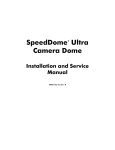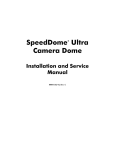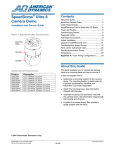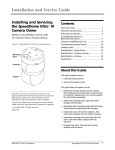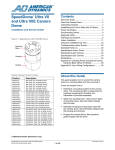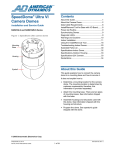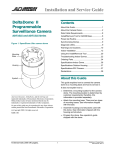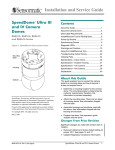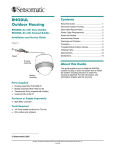Download American Dynamics RAS916LS-1 Installation guide
Transcript
WARNING! DO NOT install this camera dome in hazardous areas where highly combustible or explosive products are stored or used. ADSDUIOB / ADSDUIOBW Mounting Base Indoor Installation WARNING! This dome runs on 24Vac. DO NOT connect line voltage to this dome. Installation Guide North America power requirements: In North America, this device is intended to be supplied from a Class 2 power supply. For outdoor installations, use Class 3 wiring techniques, liquid-tight conduit, or liquid-tight pipe. This installation should be made by a qualified service person and should conform to all local codes. WARNING! EU power requirements: This product runs on 24Vac. In the EU, it is intended to be powered from a Limited Power Source. A limited power source is a certified source of SELV, and if inherently limited, with 8 amps maximum output current, and a maximum of 100VA available; or if not inherently limited, fused with a maximum value of 3.3 Amps, meeting section 2.11 of IEC950, and a maximum of 250VA available. The power supply can be obtained through American Dynamics or through another source where the provider can furnish the verification. This is required to assure electrical safety in the product. Warnings and Cautions Please review the following warnings and cautions before you install the mounting base. For additional warnings and cautions, see the camera dome installation guide. WARNINGS WARNING! Stromanforderungen in der EU: Dieses Produkt wird mit 24 V Wechselstrom betrieben. In der EU ist es für den Betrieb durch eine begrenzte Stromquelle vorgesehen. Eine begrenzte Stromquelle ist eine zertifizierte SELV-Quelle (Schutzkleinspannung), bei inhärenter Begrenzung mit einem maximalen Ausgangsstrom von 8 A und 100 VA maximaler Verfügbarkeit, bei nicht inhärenter Begrenzung mit einer maximalen Sicherung von 3,3 A gemäß Abschnitt 2.11 der IEC950 und 250 VA maximaler Verfügbarkeit. Das Netzteil kann über S American Dynamics oder eine andere Quelle bezogen werden, wobei der Anbieter den Nachweis der Konformität bereitstellen sollte. Dies ist zur Gewährleistung der elektrischen Sicherheit des Produktes erforderlich. ALWAYS USE: • Proper safety equipment for the location and type of installation. • Proper lift equipment to reach the installation. • Safety features of the lift equipment. BE SURE: • Electrical power is not connected to the dome when connecting wires. Dome will move when power is applied. • Electrical power is not connected to nearby fixtures that you might touch during installation. © 2006 Sensormatic Electronics Corp. ADSDU8IOB / ADSDU8IOBW MOUNTING BASE INSTALLATION GUIDE 8200-0600-04, REV. A 1 of 6 Cautions Before You Begin • The maximum length of power cable allowed between the Class 2 LPS (low voltage) ac source, such as a J-box, and the dome is 250m (820ft). Please read the following to ensure a smooth and successful installation. You must: • Have electrical work comply with latest national electrical code, national fire code, and all applicable local codes and ordinances. • Do not run data and power cables adjacent to or in the same conduit as line voltage mains power. • Coordinate work with other trades to avoid interference. • SensorNet 485 networks require 22 AWG unshielded cable. Do not exceed 32 devices per cable run. • Verify existing site conditions and coordinate with the owner’s representative and appropriate utilities as required. • RS-422 networks require 22 AWG shielded cable. Do not exceed 10 devices per cable run. • Obtain copies of all related plans, specifications, shop drawings and addenda to schedule and coordinate related work. • Manchester networks require 18AWG shielded cable. Do not exceed three devices per cable run. • Thoroughly review the project to ensure that all work meets or exceeds the above requirements. Bring alleged to the attention of the CCTV Project Coordinator. • Always terminate the camera dome connected at the end of a cable run. • The I/O board is electrostatic-sensitive! Use a ground strap when handling the I/O board. • The spring finger connector on the I/O board has a dust cover. DO NOT remove this cover until you have installed the dome’s base. It protects delicate spring fingers. Keep the dust cover for use should you have to ship the mounting base back to the manufacturer. Tools Required • Phillips screwdriver • Power drill with 3.2mm (1/8in), 6.4mm (1/4in), 9.5mm (3/8in), and 19.5mm (3/4in) drill bits • Hammer • Screw terminal connectors on the I/O board are delicate! Use a jeweler’s 2.5mm (0.1in) slotted screwdriver to tighten connector screws. DO NOT over tighten these screws. • Socket wrench with 152mm (6in) extension, and 5.5mm and 10mm sockets • Jeweler’s 2.5mm (0.1in) slotted screwdriver (for wire connections) • 18-14AWG and 22-20AWG wire strippers Installation • Vacuum and broom. This section explains how to attach the base and wire the I/O board. Once done, refer to installation and service Guide for the dome camera for further instructions. Perform procedures in the following order: Parts Required Item Base with I/O Board Install Kit Anchor, Toggle Screw, STAP, 4.2x32 PH Washer, Flat, M4 Nut, Locking, M3 1. Detach the I/O board from the base (page 3). 2. Attach the base indoors to a: • Tile ceiling (page 3) • Hard ceiling (page 3) • Mounting structure (page 4). 3. Wire the I/O board (page 4). 4. Reattach the I/O board (page 6). ADSDU8IOB / ADSDU8IOBW MOUNTING BASE INSTALLATION GUIDE Qty 1 1 2 2 2 2 Part Number 0101-0175-01/02 0352-0324-01 2880-0073-01 5810-4091-120 5842-0300-020 5826-0200-020 8200-0600-04, REV. A 2 of 6 Detaching the I/O Board Attaching to a Tile Ceiling To attach the mounting base, you must first remove the I/O board. To do this, push the fingers molded into the base away from the board while pushing on the I/O board with your index finger (Figure 1). Put the board in a safe place; you will use it when you attach the dome. Requires RHIUTBAR T-bar kit (optional). Attaching to a Hard Ceiling To attach the base to a hard ceiling, do the following (Figure 2): CAUTION: The spring finger connector on the I/O board has a dust cover. DO NOT remove this cover until you have installed the dome’s base. It protects delicate spring fingers. Keep the dust cover for use should you have to ship the mounting base back to the manufacturer. 1. Mark and drill holes. Place the base against the ceiling and mark and drill holes for two mounting screws. If mounting to sheet rock, also mark and drill a hole for cable access. SHEET ROCK: Drill two 9.5mm (3/8in) holes for plastic anchors. Drill one 19.5mm (3/4in) hole for cable access. CAUTION: Use a ground strap when handling the I/O board. WOOD: Drill two 3.2mm (1/8in) holes for mounting screws. If wood covers the cable access hole, drill one 19.5mm (3/4in) hole for cable access. Figure 1. Detaching the I/O board 2. Attach the base to the ceiling. SHEET ROCK: Install the plastic anchors. Then place the washers onto the screws and insert them into the anchors. Mounting Base a WOOD: Place the washers onto the screws and insert them into the wood. 3. Feed the cables through the access hole and go to “Wiring the I/O Board,” page 4. Figure 2. Surface mounting to sheet rock and wood beams I/O board Screw (2) Anchor (2) ADSDU8IOB / ADSDU8IOBW MOUNTING BASE INSTALLATION GUIDE 8200-0600-04, REV. A 3 of 6 Attaching to a Mounting Structure Wiring the I/O Board To attach the base to a mounting structure: CAUTION: The maximum length of cable allowed between the Class 2 LPS (low voltage) ac source, such as a J-box, and the dome is 250m (820ft). 1. Attach the base to the structure using the two nuts supplied with the structure (Figure 3). 2. Feed the cables through the access hole. This procedure explains how to connect the cables to the I/O board, check the cable connections, and attach the I/O board to the dome’s base. Once done, attach the housing and eyeball assembly to the base (refer to the instructions included with the housing and eyeball assembly). 3. Go to “Wiring the I/O Board,” page 4. Figure 3. Attaching the base to a mounting structure WARNING: Ensure that ac power and electrical signals are off during wire connections! ! Referring to Figure 4: 1. Set the termination jumper JW1 according to the dome’s position in the communications line. Position of dome in communications line… Between other devices End of communications line Use M3 nuts from mounting structure RHIULWM or RHIUPND Setting Unterminated Terminated Pins Off 1-2 Note: You may need a small slotted screwdriver to gently pry jumper loose. Be careful not to damage the PC board. Use M3 nuts from mounting structure RHIUWM 2. Connect the video cable to the I/O board BNC video cable extension. 3. Connect the Manchester, RS-422, or SensorNet 485 data wires to connector TB1. If using a Pelco Coaxitron or Panasonic UTC protocol, no data wires are connected, just power. Manchester data connections. Order data cable 88760 (plenum) or 8760 (nonplenum) from Belden by calling 1-800-235-3361. Use M3 nuts from mounting structure RHIUCM Pin Color Designation 1-4 — 5 Black Manchester (+) Not used. 6 White Manchester (–) RS-422 data connections ADSDU8IOB / ADSDU8IOBW MOUNTING BASE INSTALLATION GUIDE Pin Color 1 Orange Designation RS-422 Data In High (+) 2 Green RS-422 Data In Low (–) 3 Yellow RS-422 Data Out High (+) 4 Brown RS-422 Data Out Low (–) 5-6 — Not used. 8200-0600-04, REV. A 4 of 6 5. Connect the alarm output cable, if used, to the TB2 connector. SensorNet data connections Pin Color Designation 1-4 — Pin Color 5 Orange SensorNet (unshielded) 1 — 6 Yellow SensorNet (unshielded) 2 — 12Vdc (100mA max.) 3 — Output 1 (40mA sync. max.) 4 — Output 2 (40mA sync. max.) 5 — Output 3 (40mA sync. max.) 6 — Ground Not used. 4. Connect twisted pair wires, if used, to connector TB5. Pin Designation 1 Video 2 Video Ground Designation 12Vdc (100mA max.) 6. Connect the alarm input cable, if used, to the TB3 connector. Figure 4. Electrical connections Pin Color 1 — Designation Alarm 1 input (3.5mA sink) 2 — Alarm 2 input (3.5mA sink) 3 — Alarm 3 input (3.5mA sink) 4 — Alarm 4 input (3.5mA sink) 5 — Ground 6 — Ground 7. Connect power to the TB4 connector. Video Twisted Pair RS-422 Data, SensorNet Data, Manchester Data Pin Color Designation 1 Black 24Vac 2 Red Ground 3 White 24Vac 8. Reattach the I/O board. 9. Connect power to the base. Video BNC Alarm Inputs Alarm Outputs Power ADSDU8IOB / ADSDU8IOBW MOUNTING BASE INSTALLATION GUIDE Termination Jumper 8200-0600-04, REV. A 5 of 6 10. Check the LEDs on the I/O board to verify power and data are reaching the dome (Figure 5). a. The green ac power LED (CR9) glows steadily when ac power is applied. b. For Manchester or SensorNet: The yellow comm. LED (CR11) glows steadily (Manchester) or blinks (SensorNet). If this LED is off, then probably one or both communication wires are open or both are shorted together. For RS-422: Press and hold data test switch SW1 and observe nearby red (CR12) and green (CR13) LEDs; they indicate the following: Constant green, Blinking red RS-422 line correctly wired. Constant green, Red off RS-422 "Data In –" shorted to ac ground. Constant red, Blinking green "Data In +/ –" wires reversed. Blinking red, Green off "Data In +" shorted to ac ground. Both LEDs off "Data In +/ –" wires shorted or open. Reattaching the I/O Board The following procedure refers to Figure 6: 1. If the wiring is OK, then pull the excess cable up through the access hole. 2. Reinsert the I/O board. Insert the board under the retaining fingers. The board is keyed; it only fits into the base one way. Press on the board to snap it into place. 3. Gently remove the dust cover. Remove the cover from the 32-pin connector and inspect the spring finger contacts. For reliable connections, all contacts should be at least 2mm above the surface of the connector. CAUTION: Keep the dust cover for use should you have to ship the base and I/O board back to the manufacturer. Figure 6. Reattaching the I/O board Figure 5. Test switch/LEDs on I/O board Yellow (CR11) Red (CR12) Green (CR13) Green (CR9) SW1 ADSDU8IOB / ADSDU8IOBW MOUNTING BASE INSTALLATION GUIDE 8200-0600-04, REV. A 6 of 6






